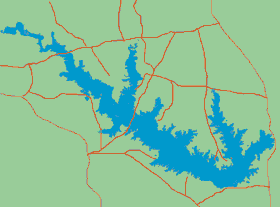Fishing
- Possession and Transport of Exotic Aquatic Species
- Licenses & Regulations
- ShareLunkers
- Fish Identification
- Fish Consumption
- Texas Freshwater Fisheries Center
Water Resources
- Texas Reservoir Levels
- US Army Corps of Engineers
- Texas Water Issues
- Golden Alga
- Aquatic Vegetation
900 CR 218
Brookeland, Texas 75931
(409) 698-9114
Dan Ashe, Biologist
Local Information
- Jasper Chamber of Commerce
246 E. Milam
Jasper, Texas 75951
(409) 384-2762 - Lufkin/Angelina County Chamber of Commerce
1615 S. Chestnut
Lufkin, Texas 75901
(936) 634-6644
Nearby State Parks
Sam Rayburn Reservoir
Quick Links: Fishing Regulations | Angling Opportunities | Cover & Structure | Tips & Tactics
Lake Characteristics
Location: On the Angelina River; dam is located in Jasper County approximately 15 miles north of
Jasper.
Surface area: 114,500 acres
Maximum depth: 80 feet
Impounded: 1965
Water Conditions
Current Lake Level
Conservation Pool Elevation: 164.4 ft. msl
Fluctuation: Average 7 feet
annually
Normal Clarity: Ranges from relatively clear in the lower lake to off-color in upper lake
Consumption Advisory in effect
Reservoir Controlling Authority
US Army Corps of Engineers
Jasper, Texas 75951
(409) 384-5716
Office
Hours: 8 am - 4:30 pm Mon. - Fri.
Aquatic Vegetation
Primarily hydrilla, American lotus and pondweed. A variety of other aquatic plants is also established.
Predominant Fish Species
Lake Records
Current
Fishing Report
Stocking History
Latest Survey Report
Lake Maps
General maps are available at the Corps of Engineers Project Office at Sam Rayburn Dam. Topographic maps are available at local sporting goods stores and tackle shops.
Fishing Regulations
This reservoir has special regulations on some fishes. See bag and size limits for this lake.
Angling Opportunities
The most popular game fish at Sam Rayburn Reservoir is the largemouth bass; an excellent year-round fishery exists. Excellent year-round crappie and catfish fisheries are also present. White bass numbers are limited, but provide good fishing opportunities during the spring. Bluegill and redear sunfish are present in high numbers and provide good fishing, especially for youth or inexperienced anglers.
| Species | Poor | Fair | Good | Excellent |
|---|---|---|---|---|
| Largemouth Bass | ||||
| Catfish | ||||
| Crappie | ||||
| White Bass | ||||
| Sunfish |
Fishing Cover/Structure
Habitat in Sam Rayburn Reservoir consists of submerged aquatic vegetation, standing timber, and flooded terrestrial vegetation. Hydrilla is the predominant plant species, although many native plants such as coontail and pondweed are also present. In the lower part of the reservoir the water is relatively clear; game fish are typically found around vegetation edges, flats, humps, and creek channels. In the upper third of the reservoir, the abundance of vegetation typically declines. Timber, brush, laydowns, and creek channels provide upper-lake game fish habitat. A few man-made fish attractors provide additional structure. Anglers may use GPS in conjunction with a fish finder to locate these structures.
Use the Habitat Structure Viewer for an interactive map of fish habitat structures and downloadable GPS coordinates.
Due to water level fluctuations, habitat conditions change seasonally and yearly. Drastic water level changes can decrease the amount of vegetation. At high water levels, inundated trees and bushes provide excellent habitat.
Tips & Tactics
Anglers are successful at catching largemouth bass year round at Sam Rayburn Reservoir. During the fall, winter and spring months, fish are active for longer periods of the day and are typically found in shallow water. A variety of baits and techniques will work during these times, but crankbaits and spinnerbaits are usually the preferred choices. During the hot summer, the bite usually slows and fish activity is usually concentrated during early morning, late evening, and at night. Topwater baits are good choices during low light conditions. As the sun rises, most bass concentrate in or around vegetation edges and man-made brush piles, or seek refuge on deep ledges and creek channels. During this time, plastic worms, jigs, and Carolina rigs are preferred baits.
Crappie fishing is excellent year-round with jigs and minnows. During the spring spawn, anglers target shallow areas around vegetation. During other times of the year, fish are typically concentrated in deeper water around brush piles and creek channels.
